Every time I go to Germany I try to spend some time in the company of Jens Meyer – not just because Jens and his wife, Susanne are great company, but because Jens, who first worked at the State Stud Celle, before setting up his own stallion station on his family farm at Dorum, knows so much about horse breeding. It is no wonder that he is in great demand from breeding associations all over Europe as a classifier and judge. As we settled down with some freshly brewed coffee, the question was:
If I want to buy a foal and I am coming to the Hanoverian Foal Auction, how can I increase the chance of getting a good foal?
“At the auctions, they are really well selected foals. We have 8000 foals and for all the breeders it is a big deal to bring their foal to the Foal Auction because they have a very good chance of getting a good price. They offer all their good foals at the selections, and so what makes it to the auction, is very high quality.”
“It is a little difficult to make a selection because the foals are all different ages, and picking the quality in foals so young is not that easy. But most of them that come to the auction have been winners at the Foal Shows. For example, at my Foal Show there are 80 foals, and they select the top three to five to go to the auction.”
When you get to the Auction, you have several chances to see the foals?
“The first chance we have is with the DVD and the catalogue before the auction. Then you can look at the catalogue to find related horses, what they are doing, how they are competing, what is the quality of the mare. In the end, every foal is pretty, but three years later it looks like the mother. For me, the best option is to buy a foal out of a high quality mare – the dam side is more important than the stallion. Buying a foal is a big chance to get a top horse because when the same foal is two or three, then it would probably be too expensive.”
What are the important things to look for?
“There are some things we don’t want to see. For example, you have a foal that is trotting around with the tail up, that means the foal is not relaxed, it doesn’t show it’s true movement. It’s as if you put your riding horse into the box for 14 days, and you let him out, he shows something that is really not there. So you want to see a foal that is relaxed, his tail and his back are swinging, and the hind end, the engine is good. With a foal, to see the movement is a little special, and to get a guarantee you need to find the answer in the pedigree, and out of the construction, and out of the success the mare has in the performance test. Then you look at the stallion book of Mr Christmann (the annual Hannoveraner Jahrbuch Hengste) and look at what the stallions have produced, then you can see a red line, that shows this is what the stallion produces. Compare then the stallion’s results with the results on the mare’s side, and you nearly get a guarantee that you get the foal you want.”
“For me, when I am looking for a dressage horse, it must have different construction than a jumper. Especially for the dressage horse, the top line is very important – but to see in a foal how the top line will develop is very difficult. That’s when you have to think about the stallion and the mare. Even when you look at the first presentation of the foals, you cannot be sure – some foals do not show so well that day – the foal has traveled two hours to the auction and maybe doesn’t show so well. There are some really smart breeders and they can get their foals to trot, but what you see is not always what you get – better to think about the pedigree. So after I have looked at all the foals, I mark the ones I am interested in, and then I want to see the foal on the hard ground. There you see the truth – not with the whip – just that the foal moves there and you can see if the foal is correct, and that the feet are good. Nobody talks about this, but enough problems come later, we don’t need to start with feet problems. We want good legs. Okay some foals when they start are not entirely straight, but you must decide is this a problem or not? This you can see on the hard ground, not in the grandstand, fifty metres away.”
(The hard ground, Jens is referring to is the bitumen road, next to the stables where the mares and foals are kept. It is perfectly acceptable to go back to the stable and ask the breeder to bring the foal out for a further examination…)
“The walk is also essential. When you see a foal inside the Auction Hall, they present them in trot and it is very difficult for the foal to come back relaxed and walk, once again, you can see if the walk is correct on the hard ground. But there will still be a little speculation, because every foal can walk because they have long legs and a small body – this is when you look again to the mother, what is her walk like? Look at the mother, look at the foal, and compare – how will the foal develop? Specially for a dressage horse, the conformation is the important thing not just a pretty foal.”
“What is important is where the hock is, and in a foal you cannot see it – you have to know the stallion and his conformation, and again, look at the mare. You can’t see it in the foal. The stallion has this, the mother has this, then it could be that this foal will have the right position for the hock.”
For a dressage horse, there are some stallions that are breeding horses that are slow and out behind?
“In the Hanoverian ten years ago, we needed canter, so we used a lot of Holstein bloodlines but then in the end you get also the problem from the Holstein – same with the Thoroughbred. We want to see that blood in the third generation – once again, analyse the pedigree. Fifteen years ago, it was fashionable to try and breed a Holstein dressage horse. You go and look at them at the stallion selection when they are two and a half, and wow, very good movement – but when you go to ride them – no movement. This is a problem, the horses can’t work through the back, they are not swinging, and in the end, not dressage horses. In this time we saw Corlandus and some very good Holstein dressage horses, so you can find them, but you are very lucky if you find them, but most of them we need not for dressage. So when you find a pedigree that is half Holstein and half Hanoverian and use them as a dressage horse, the risk is high that you have a horse with no swinging back – it’s best not to buy those problems, they come by themselves.”
“The L line in Holstein was the line where they tried to save the movement in Holstein, and their breeding authorities are really anxious to bring back the L line to get the movement, because they have a closed studbook and it is not very easy for them. You can see it with Landadel, he produced some very good dressage horses, especially with Hanoverian lines, but there was always a problem with the walk, not enough walk.”
“When you see dressage horses, and the breeding is just dressage, dressage, dressage and there is no jumping blood in it, you lose the canter. It is also very important that the dressage horse does a little jump because you see the willingness in a horse – and they must have a willingness. For me, when I bring my stallions to the performance test, all my good dressage horses must also do the cross country. This says, this horse wants to work.”
“For example in the Dutch Studbook, they do not ask their dressage horses to jump, and I don’t think this is the right way. It is important that they have a strong back and this you can lose when you go just one way. So when we look at the pedigree we need a lot of experience.”
Ramiro?
“Yes, I have a stallion with Ramiro on the pedigree, and I am very pleased with this. This was from a generation where the horses could carry themselves and were not so specialized in jumping when they went to the performance test they did everything. But now the jumping lines are so specialized that they can nearly not do the performance test, they cannot carry themselves, they are not swinging. In the end, a stallion for me, must be able to do all the elements of the performance test. When we have just specialized horses, you can see it in the French breeding. Mr Melchior did it also, he bred jumpers, with jumpers, with jumpers, and in the end, he has no horse – it jumps two metres but you cannot ride into a corner. Function comes from construction, and this is very important.”
“When we buy a jumper foal, we must still have rideability. Do you want a horse that needs an artist or an acrobat to sit on it? Maybe that artist can get the horse to the fences, but in the end, with a horse, we want to have fun.”
What lines do you like to see on top for a dressage foal?
“When we are talking about lines it is difficult. Lines have become like fashion, you have a red or a green pullover, which one do you like more? We have to find out, this line can do this, and this line can do that – this line is breeding to this mare family… We must see the horse and not the bloodline. In every pedigree, we find a stallion we don’t like. Or we find always a reason that we can say this pedigree is good, or this pedigree is bad. To find what the whole family is doing is very important for me. It’s not like buying a car – you want that colour, so much horsepower, it is very easy, but in a horse it is not so easy. I go out and buy a Sandro Hit / Donnerhall / Rubinstein, and I have a good horse? No.”
But can you say, I want a dressage horse, but I can’t stand spooky horses?
“Yes, we have lines that are spooky. I give an answer from the past. When you say Argentan, and he produced many horses that were a little spooky but in his time the stallion was good, he produced type. So you get the type from him but you get the problem that sometimes they are spooky. But when you know from the mare family that they are super honest horses and they need blood, they are too slow and have not the willingness, and you have a slightly spooky stallion, that can work. But when people say, every Argentan is spooky, this is not true. He was good for our breeding, he produced a World Cup winner. Okay he was not a stallion maker, and this was a shame, but in the end when you are thinking about 20 years ago, they were very good horses, and you can see the family today. Lancet is an international horse at the moment, so out of this family, very good horses.”
As a practical demonstration of ‘reading’ a pedigree, I asked Jens to talk about one of the young stallions he has in his barn, Lord Laurie.
I’m interested that you have a young stallion by Lord Loxley, I guess you don’t like the pedigree of Lord Sinclair…
“Okay let us look at the papers from Lord Laurie. Okay with Lord Sinclair you say, it could be better, but when you see Lord Loxley’s pedigree – I rode this mare, Weltlady by Weltmeyer. I rode Weinlady, and I know her mother, this Domspatz mare. In the end, Lord Sinclair was a champion, he was a trot horse, and is now doing Grand Prix. Lord Loxley is another successful competitor. This Weltmeyer mare, Weltlady scored over 8 in her performance test, and she was also a trot horse. She won material classes, and she was sold for big money to Belgium. Weinlady by Weingau, she was also a trot horse, she really could move, then comes Domspatz and then Marcio blood. In the end you have a really big chance, that you produce trot. And we need trot for the future.”
“What you don’t have on this pedigree is any refiner, and in the end you end up too heavy. So then you have to look at Laurie, a mare I bought at the farm of Max Schultz. He was giving up breeding, she was two years old, together with her mother, not weaned! I bought her, it was like bringing a deer from out of the forest into a trailer – can you imagine! Then I give this mare to a breeder, he really cared for this mare. He rides her and with her he won the title, Champion of East Germany with a daughter from her. Then he sold her back to me because he was going in a different direction – so we took the mare into the Hanoverian book, and she scores 8, and that is a big deal, Main Stud Book with a score of 8. She is a very pretty mare, you see the influence of Lauries Crusador, he gives the neck, legs and saddle position – uphill. In the end, he gives us what we want from the Thoroughbred. And this we need because otherwise we have breeding of the old days – of the 70’s – and in the 70’s we have correctness, good legs, strong legs, a good back, all things we lost with this fashion breeding, but we need a drop of Thoroughbred blood in it to give these old bloodlines what they lack.”
“Then comes jumper blood, but this mare, Gretel, she produced an S level dressage horse, and an S level jumper. Then comes, Ferbel by Ferdinand, and she is the grand-mother of Brentano.”
But I have seen this mare, Ferbel, she looked like a tank…
“She looked like a tank. Short legs, so it is important to have this Thoroughbred blood, but from ‘the tank’ we get powerful movement. She was born in 1968. Then the breeders used just pretty stallions, pretty stallions, but we lose movement. When you look at the heritability, movement and type is not together, when you get them together, you have a horse worth a million. So we look for solutions. Look back a little further, here comes Marbel, she is the mother of the two Garibaldis.”
“Now with Lord Laurie we must see what happens. I am very glad that the breeders have used him quite well. We didn’t show him for the Bundeschampionate or anything, hopefully he makes good foals, which is what we want. Especially what I want is a lot of influence of Lauries Crusador in the third generation… we did this before with Absatz in the third generation. Hopefully from the old lines we get the trot, and hopefully from Lauries we get the good conformation and correctness… but we will see.”
And yes, it will be fun to see what the young stallion produces. Thanks again Jens for your time and wisdom…
This article originally appeared in the March 2010 edition of The Horse Magazine

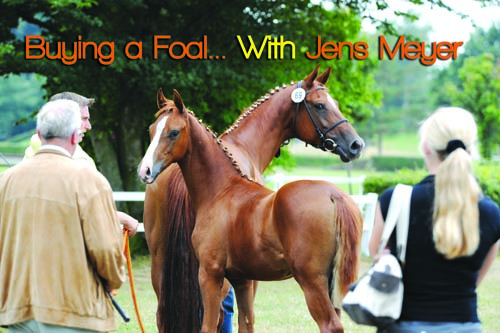
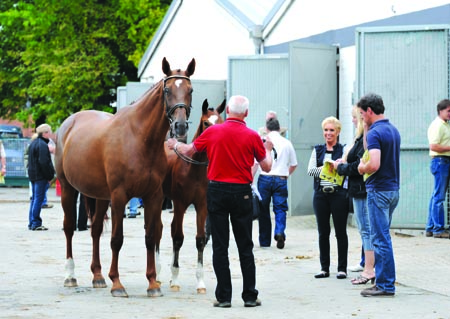
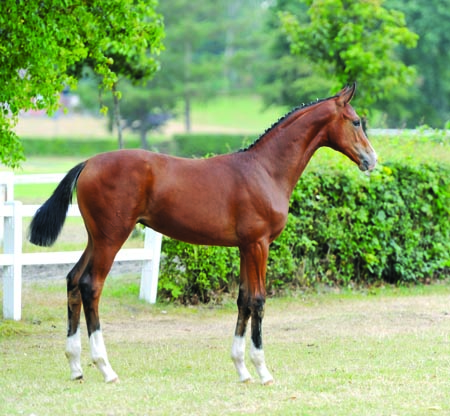
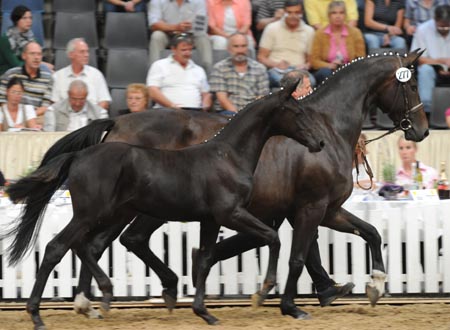
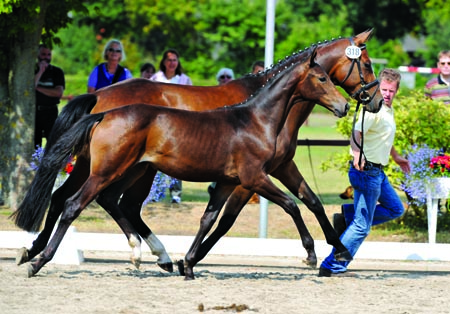
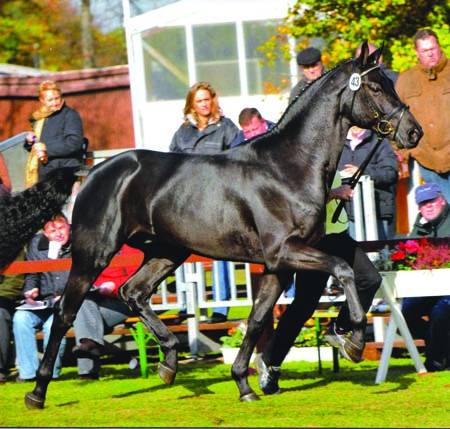
Can you please start sending me these helpful and informational articles to my Email I will really appreciate it, because I am going to be getting a horse hopefully by 14 years old. I am starting to save money for the horse and/or foal and of course the supplies for them or it :). Oh, and by the way, I am starting horse riding lessons when I am 12. I am 10 years old and Thank You. 🙂
Good for you Navaeh! Keep working towards your goal and make it happen 🙂 You sound a lot like me when i was little. I had to wear my parents down and got riding lessons for one month when i was 11 for my birthday…been riding ever since 😉 im 44 now. I think you should invest in a book. ‘Basic Training of the Young Horse’ by Ingrid and Reiner Klimke. 2 years of lessons before buying a horse is a good plan. That way you’ve learned enough to choose well. Best of luck to you!